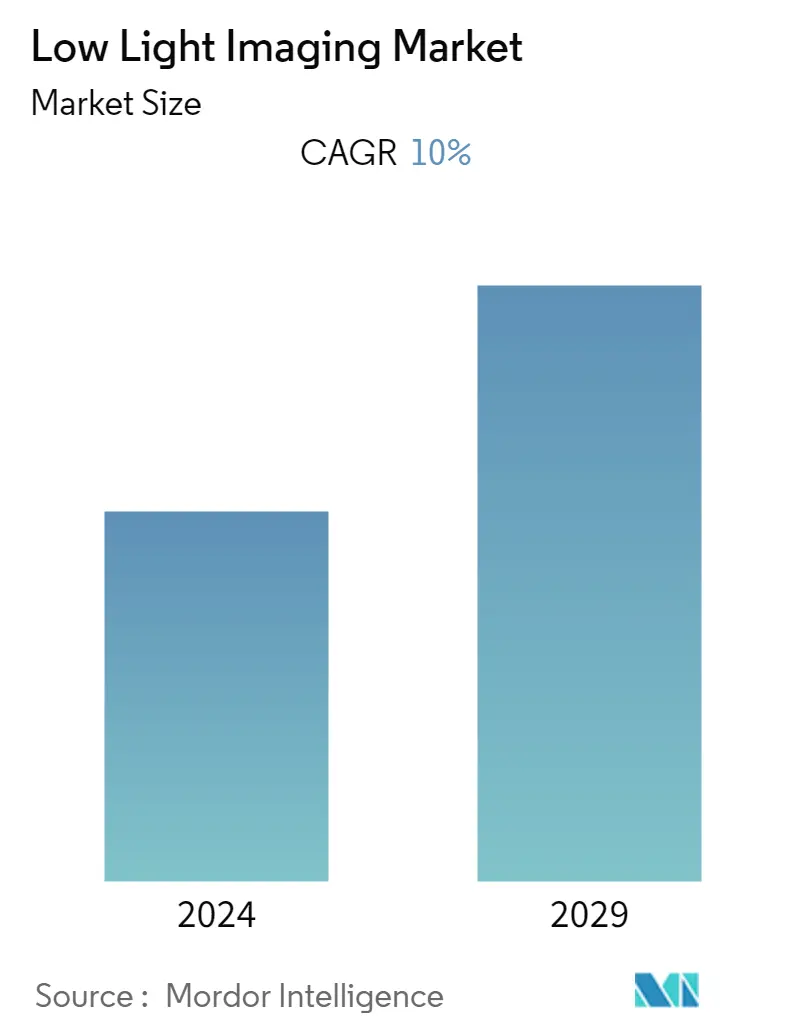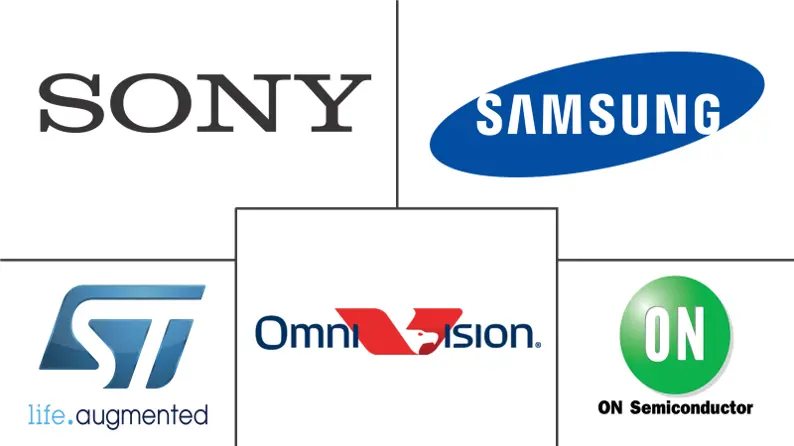Market Size of Low Light Imaging Industry

| Study Period | 2019 - 2029 |
| Base Year For Estimation | 2023 |
| CAGR | 10.00 % |
| Fastest Growing Market | Asia Pacific |
| Largest Market | Asia Pacific |
| Market Concentration | Low |
Major Players
*Disclaimer: Major Players sorted in no particular order |
Low Light Imaging Market Analysis
The Low Light Imaging Market is expected to register a CAGR of 10%, over the forecast period 2021-2026. Low-light imaging is a technology used to improve the visibility of the image in dimly lit environments. The advancements in low-light technology have significantly improved sensitivity in the IP cameras and enabling capabilities to capture color images in as little as 0.1 lux illuminance.
- The industry-wide shift from CCD to CMOS sensors, which are not only less expensive to manufacture, but also offer a more flexible approach in how pixels are read and processed, enable the industry to be able to do more. It's created an enormous trajectory path leading to low light imaging solutions.
- The industry also witnessed improvements in chipsets even have gone a long way toward providing additional processing power to run more complicated algorithms for low-light image processing to render more activity and better adjust to scenes. The ability to reproduce low-light images in a highly specific color has been a critical factor in driving the continued improvement and evolution of low-light cameras.
- In the low-light scenarios, the combination of a large low-light sensor, large-aperture lenses, and proper backlighting or IR illumination is required for optimum performance. In the future, AI technology is expected to make significant improvements to low-light technology, further enhancing the image captured by the camera.
- In November 2019, the Sony A7R IV I sensor achieved an overall DXOMARK score of 99, and it especially stood out for its low light ISO and dynamic range score. Even with an increase in the density of pixels for a full-frame sensor, the sensor still performs tremendously well in the Low-Light ISO score.
- With the outbreak of COVID-19, drones are becoming vital tools in the fight against the pandemic across states with law enforcement agencies using them to monitor public gatherings, ensuring social distancing, spraying disinfectants over locations, among others. Most of the drones are equipped with larger CMOS image sensors, which makes it easier to capture high-quality images in low light.
Low Light Imaging Industry Segmentation
The low light imaging sensors generally incorporate two types of technologies which are CMOS and CCD. Low light imaging solutions are used in various applications such as low light photography, scientific imaging, medical imaging, space imaging, security and surveillance and are even used in various end-user verticals which include electronics, automotive, military and defense.
| Type of Image Sensor | |
| Charge-Coupled Device (CCD) | |
| CMOS sensor (Active-Pixel Sensor) |
| Application | |
| Scientific Imaging | |
| Medical Imaging | |
| Security and Surveillance | |
| Space Imaging | |
| Low Light Photography | |
| Others |
| End-user Industry | |
| Electronics | |
| Automotive | |
| Military and Defense | |
| Other End-user Industries |
| Geography | ||||||
| ||||||
| ||||||
| ||||||
| ||||||
|
Low Light Imaging Market Size Summary
The low light imaging market is experiencing significant growth, driven by advancements in technology that enhance image visibility in dimly lit environments. The transition from CCD to CMOS sensors has been a pivotal development, offering cost-effective manufacturing and flexible pixel processing capabilities. This shift has propelled the industry forward, enabling more sophisticated low light imaging solutions. Improvements in chipsets have further contributed by providing the processing power needed for complex algorithms, enhancing the ability to capture color images in low light conditions. The integration of AI technology is anticipated to further refine these capabilities, improving image quality and performance in low light scenarios.
The market is characterized by a fragmented landscape with numerous international players, including Sony Corporation, Samsung Electronics Co Ltd, and OmniVision Technologies, Inc., who are continually innovating to maintain their competitive edge. The Asia Pacific region is poised for substantial growth due to the high demand for low light imaging solutions in automotive and electronics manufacturing, with major companies investing heavily in research and development. Despite challenges such as the COVID-19 pandemic impacting production in regions like India, the market continues to evolve with advancements in smartphone camera technology and the development of under-display cameras, which require enhanced low light imaging sensors.
Low Light Imaging Market Size - Table of Contents
-
1. MARKET DYNAMICS
-
1.1 Market Overview
-
1.2 Market Drivers
-
1.2.1 Increased usage of Low Light Photography in Smartphones
-
1.2.2 Enhancements in the sensor technologies and processing power
-
1.2.3 Deployment of Artificial Intelligence in the low light imaging solutions
-
-
1.3 Market Restraints
-
1.3.1 Outbreak of COVID-19 is expected disrupt the manufacturing sector
-
-
1.4 Supply Chain Analysis
-
1.5 Industry Attractiveness - Porter's Five Forces Analysis
-
1.5.1 Threat of New Entrants
-
1.5.2 Bargaining Power of Buyers/Consumers
-
1.5.3 Bargaining Power of Suppliers
-
1.5.4 Threat of Substitute Products
-
1.5.5 Intensity of Competitive Rivalry
-
-
-
2. MARKET SEGMENTATION
-
2.1 Type of Image Sensor
-
2.1.1 Charge-Coupled Device (CCD)
-
2.1.2 CMOS sensor (Active-Pixel Sensor)
-
-
2.2 Application
-
2.2.1 Scientific Imaging
-
2.2.2 Medical Imaging
-
2.2.3 Security and Surveillance
-
2.2.4 Space Imaging
-
2.2.5 Low Light Photography
-
2.2.6 Others
-
-
2.3 End-user Industry
-
2.3.1 Electronics
-
2.3.2 Automotive
-
2.3.3 Military and Defense
-
2.3.4 Other End-user Industries
-
-
2.4 Geography
-
2.4.1 North America
-
2.4.1.1 United States
-
2.4.1.2 Canada
-
-
2.4.2 Europe
-
2.4.2.1 Germany
-
2.4.2.2 United Kingdom
-
2.4.2.3 France
-
2.4.2.4 Rest of Europe
-
-
2.4.3 Asia-Pacific
-
2.4.3.1 India
-
2.4.3.2 China
-
2.4.3.3 Japan
-
2.4.3.4 Rest of Asia-Pacific
-
-
2.4.4 Latin America
-
2.4.4.1 Brazil
-
2.4.4.2 Argentina
-
2.4.4.3 Rest of Latin America
-
-
2.4.5 Middle East and Africa
-
2.4.5.1 United Arab Emirates
-
2.4.5.2 Saudi Arabia
-
2.4.5.3 Rest of Middle East and Africa
-
-
-
Low Light Imaging Market Size FAQs
What is the current Low Light Imaging Market size?
The Low Light Imaging Market is projected to register a CAGR of 10% during the forecast period (2024-2029)
Who are the key players in Low Light Imaging Market?
Sony Corporation, Samsung Electronics Co Ltd, OmniVision Technologies, Inc., ON Semiconductor Corp and STMicroelectronics Inc are the major companies operating in the Low Light Imaging Market.

